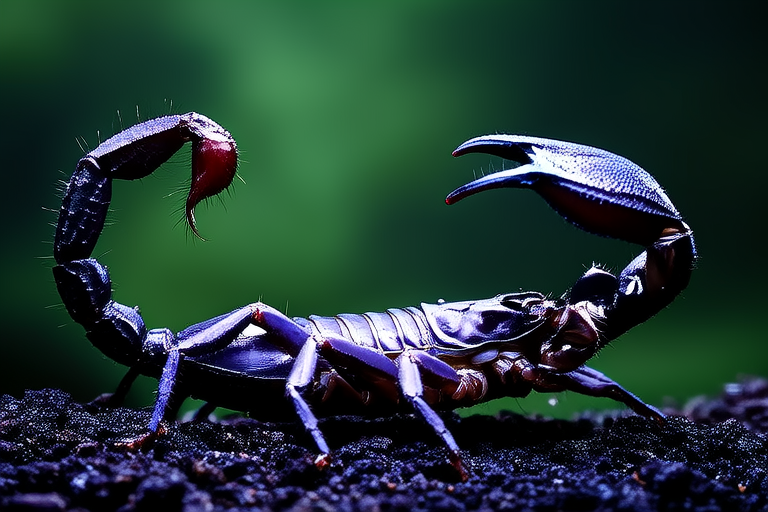
Unveiling the Mysterious World of Heterometrus Spinifer: A Close Encounter
Heterometrus spinifer, commonly known as the Indian forest scorpion, is a fascinating member of the scorpion family. This creature belongs to the order Scorpiones and the family Scorpionidae, which includes some of the most diverse and widespread arachnids in the world. The Heterometrus genus, of which H. spinifer is a part, is characterized by its robust build and formidable size, making it one of the largest scorpions in Asia.
Physical Characteristics
The Indian forest scorpion is easily distinguishable by its thick, dark brown exoskeleton, often tinged with yellow or greenish hues. Its most striking feature is the pair of prominent pincers, or pedipalps, used for grasping prey and defense. These pincers are complemented by a segmented tail tipped with a venomous stinger. The overall body length can reach up to 15 centimeters, with males being slightly larger than females. Their coloration serves as effective camouflage against predators, blending seamlessly with the leaf litter and soil of their natural habitats.
Natural Habitat and Distribution
Native to the tropical and subtropical regions of Southeast Asia, H. spinifer thrives in humid environments with dense vegetation. It is predominantly found in India, Thailand, Malaysia, and parts of Indonesia. These scorpions prefer to reside in moist, shaded areas such as under rocks, logs, and within the hollows of trees. They are nocturnal, emerging at night to hunt and avoid the harsh sunlight that could dehydrate them.
Their preference for humid climates extends to their burrowing habits. Heterometrus spinifer constructs complex underground burrows that serve multiple purposes: shelter from predators, protection from extreme temperatures, and a strategic location from which to ambush prey. These burrows are meticulously maintained, reflecting the scorpion’s industrious nature.
Behavior and Survival Strategies
The Indian forest scorpion is a solitary predator, relying on stealth and speed to capture its prey. Its diet primarily consists of insects, spiders, and small vertebrates. Hunting is a delicate process involving patience and precision. The scorpion uses its highly sensitive sensory structures, particularly the pectines located on the underside of its abdomen, to detect vibrations and chemical cues from potential prey. Once detected, the scorpion swiftly strikes, injecting venom through its stinger to immobilize the target.
One of the most remarkable aspects of H. spinifer‘s behavior is its ability to adapt to environmental changes. In times of scarcity, it can enter a state of dormancy, reducing its metabolic rate and conserving energy until conditions improve. Additionally, the scorpion exhibits a unique form of parental care, with females guarding their eggs and newly hatched offspring until they are capable of fending for themselves.
Misconceptions About Scorpions
Scorpions, including H. spinifer, often evoke fear and revulsion due to their menacing appearance and reputation for delivering painful stings. However, it is important to recognize that their venom is primarily used for subduing prey and self-defense. The majority of scorpion species pose little threat to humans, and their sting is more of a nuisance than a danger.
Understanding these creatures beyond the myths surrounding them fosters a greater appreciation for their role in ecosystems. By studying scorpions like H. spinifer, scientists gain valuable insights into evolutionary adaptations, behavior patterns, and the intricate web of life in various habitats.
Interactions with Other Species
In the complex ecosystem where H. spinifer resides, it plays both predator and prey roles. As a top predator among smaller arthropods, it helps control insect populations, contributing to the ecological balance. Conversely, its own vulnerability to larger predators such as birds, reptiles, and mammals underscores its position within the food chain.
The scorpion’s interactions with its environment extend beyond predation. It shares its habitat with a variety of other organisms, each contributing to the biodiversity of the region. For instance, certain fungi and bacteria have evolved symbiotic relationships with H. spinifer, providing mutual benefits such as enhanced digestion and protection against pathogens.
The Significance of Studying Heterometrus Spinifer
Studying H. spinifer offers invaluable lessons about ecological resilience and adaptation. By examining its behavior, physiology, and interactions with other species, researchers can better understand how ecosystems function and respond to change. This knowledge is crucial for developing conservation strategies and managing natural resources sustainably.
Moreover, the study of scorpions like H. spinifer contributes to advancements in medical science. Research into their venom has yielded compounds with potential applications in pain management, neurology, and cancer treatment. Each new discovery brings us closer to harnessing the power of nature for human benefit.
Conclusion
The Indian forest scorpion, Heterometrus spinifer, is a testament to the diversity and complexity of life on Earth. From its striking appearance to its intricate behaviors, this creature invites us to explore the natural world with curiosity and respect. By dispelling misconceptions and fostering appreciation for such species, we can promote a deeper understanding of our planet’s ecosystems and inspire future generations to protect and preserve them.
Encouraging readers to approach wildlife with open minds and hearts, we hope to inspire a new wave of environmental stewards who will cherish and safeguard the wonders of nature for years to come.



